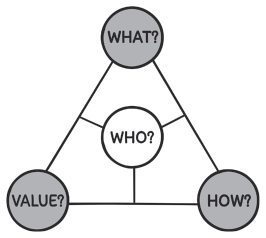Prosumer
Producer and consumer at the same time

The pattern
Within the Prosumer business model pattern, companies enable customers to become producers themselves. The customer is integrated into the value chain and can profit from the resulting product (HOW?), while the company has fewer investment costs for production and overheads (VALUE?). The firm has the power over the organisational infrastructure that enables the value delivery of the value proposition. Since the consumer has a hand in production, the perceived value of the product increases (WHAT?).

Although the term ‘Prosumer’ is sometimes also used to describe semi-professional consumers who are willing to purchase high-end gear designed for professionals or businesses (e.g. cameras), the business model pattern of Prosumer refers to Alvin Toffler’s definition in his 1980s seminal book The Third Wave. Coining several terms that are used within the context of the third social wave of the Information Age, a prosumer describes individuals that are producers and consumers at the same time.
By involving the consumer as a potential and relevant part of the value chain, Prosumer shows similarities with other business models that include external parties in their value creation architecture, such as Crowdsourcing (#9). From a value-capturing perspective, Prosumer is compatible with approaches such as Pay Per Use (#35) or Sensor as a Service (#56).
The origins
Through the enhanced tracking opportunities provided by new sensor technologies, better network embeddedness and general technological developments, this pattern shows increasing use although already applied several years ago. The first appearances of blurring the separation of producers and consumers can be found in the Self-Help Cooperative Movement(s) during negative social events such as the Great Depression in the 1930s. Describing a bottom-up response to the economic crisis at that time, unemployed workers from the city reached out to farmers to work on their farms in exchange for food. They became producers and consumers at the same time – a monetary transformation took place only in their heads but not from a physical standpoint, making the transaction more efficient as no third-party securitisation (e.g. a central bank) was needed, which was unattractive anyway because of the currency devaluation that comes with such negative social events.
The innovators
Prosumer is already an established pattern in the energy sector in different forms. With the rise of renewable energy production, private households also contribute to the increasing number of solar panels and wind power turbines. Promoted by the energy-producing companies to optimise infrastructure utilisation, and financially supported by governments to kickstart a private utility installation in the beginning, former consumers could feed in their produced energy to the grid to benefit from pre-defined tariffs. Building on this, the concept of a smart grid has gained traction. Depicting independent energy communities where consumers act as energy suppliers and producers, only energy consumption gaps that cannot be covered by the local production from various energy sources such as solar, wind or wood pellets are provided by energy providers. Enabled by a variety of IoT devices, including smart meters and smart appliances, a smart grid operates independently but allows synchronisation with the national energy network to level out peak loads in energy consumption so that the infrastructure can run with appropriate utilisation rates on a constant basis.
Prosumer: smart grids

The Prosumer pattern is also applied in the field of distributed ledger technologies. These protocols follow the model of a distributed ledger, where participants can utilise the system but also serve as an institution of confirmation for others. While the development of a Blockchain can be ascribed to the founders, the ongoing development comes from prosumers who are both using and extending the Blockchain, as well as potentially providing additional services within the respective ecosystem.
Prosumer is also a common business model for social Internet platforms. Depicted by the social currency of numbers of followers, platforms such as YouTube or Facebook are crowded with users who are professional producers of content that is then consumed by others. Being prosumers, they earn money by allowing the providers to play dedicated advertisements before their videos. Decoupled from the platforms’ Prosumer model, these influencers can also benefit from affiliate links or commissioned production of videos for partners. In 2018, according to Forbes, the best-earning Prosumer on YouTube was Mark Fischbach with his pseudonym ‘Markiplier’, who earned around US $17.5 million annually by mostly showing how he plays video games. With 24.5 million subscribers in November 2019, he provides content to a large number of users whom YouTube can approach with advertisements. Assumed to have generated US $16 to 25 billion in revenue in 2018 by the New York Times, the Prosumer pattern is a very important building block to which YouTube connects its additional marketing revenue streams.
When and how to apply Prosumer
Prosumer is a pattern that fits well with platform business models and organisations that provide infrastructures that can be flexibly adjusted to integrate customers as resources or sources of supply. Although making coordination more complex, highly creative business model combinations can be used to monetise the benefits arising from this, as presented in the case of YouTube. It is important to balance the incentives for Prosumers and the value capture of the respective company, so that ongoing involvement is guaranteed and growth facilitated.
Some questions to ask
- What incentives exist for customers to become Prosumers?
- Which revenue logic do we install to make Prosumer beneficial for us?
- What other partners do we integrate in the Prosumer system?
